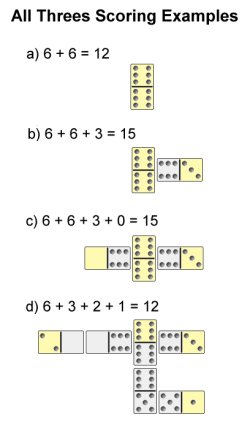All Threes Domino Rules
How To Play All Threes Dominoes
Number Of Players: 2 to 4
Domino Set Required: Double-Six
All Threes is similar to All Fives, the main difference that scoring is based on multiples of 3 rather than 5.
Setup
After shuffling the dominoes, each player draws a single tile to determine who goes first; the lead goes to the heaviest tile (this is known as "drawing lots". These tiles are then returned to the stock and reshuffled.
Each of the player then draws 5 tiles to make up their hand. The remainder of the tiles make up the boneyard (or "stock"), and are held in or reserve to be drawn upon at need.

Gameplay
The first player downs the first domino. The first tile may be of any value, and need not be a double. However, the first double played, whether it is the initial tile or not, can be played off of on all four edges. This initial double is known as the spinner. All subsequent doubles can only connect on two edges.
Play proceeds to the left (clockwise). Each player adds a domino to an open end of the layout, if he can. If a player is unable to make a move, he must draw dominoes from the boneyard until he can make a move. If there are no dominoes left, then the player must pass.
Scoring
The object of the game is to make to make the open ends of the layout add up to 3 or a multiple of three, (3, 6, 9, 12, 15, etc.). The player who makes such a score receives that number of points.
At any time there may be 2, 3, or 4 open ends. When a double is first played, all of its dots count toward the total.
Examples
- If the first tile placed is a 6-6, then the player scores a 12. At this point all sides of the 6-6 are available for play.
- If the second tile placed is a 6-3, then the player scores 15. At this point three sides of the 6-6 are available for play, as well as the 3.
- If a 6-0 is played to th left edge of the 6-6, then that player scores 15 as well. At this point only two sides of the 6-6 are available for play, as well as the 3, and the 0.
- If a 0-2 is played on the 6-0, the total is 11 (6 + 6 + 3 + 2), so that move scores no points. If the next move is a 6-5, then the total is 16 (6 + 5 + 3 + 2), so no points again. If a 5-1 is then played off the 6-5, the total is 12 (6 + 3 + 2 + 1), so points are scored.
Ending A Hand
A hand ends either when a player plays all his tiles, or when a game is blocked, at which time the lightest hand wins total of his opponents points (minus any points in hs own hand), rounded to the nearest 3, and divided by 3. For example, if the winning player has 3 points in his hand, and his three opponents have 5, 11, and 13, then the total difference is 26 (5 + 11 + 13 - 3). This is rounded up to 27 and divided by 3. Thus, 9 additional points are added to the winner's total. All players retain the points that they have attained during gameplay, but only the winner gets the bonus points at the end of a hand.
Winning A Game
A game is generally played to 100, 200, or whatever is agree upon before the game begins.
A Cribbage board can also make a handy scorekeeping device. If a Cribbage board is used, the point totals during play (3, 6, 9, etc.) are divided by 3, yielding 1, 2, 3, etc. End-of-hand bonus points are still given full value (in which case they become even more important). Games played using a Cribbage board are typically played to a score of 61.
Variations
- The ends of the initial double (the spinner) do not count towards the point total once both sides of the tile have been played. If using this rule, then the pips on the "6-6" in examples "c" and "d" in the above diagram are not included in the total points.

 Dominoes Info
Dominoes Info